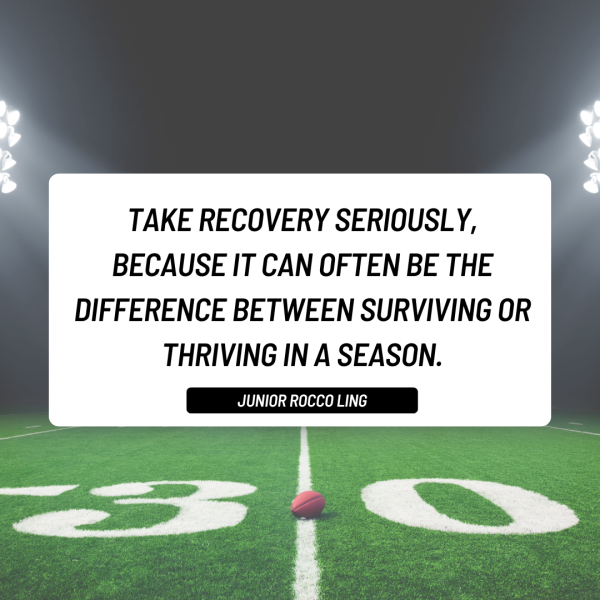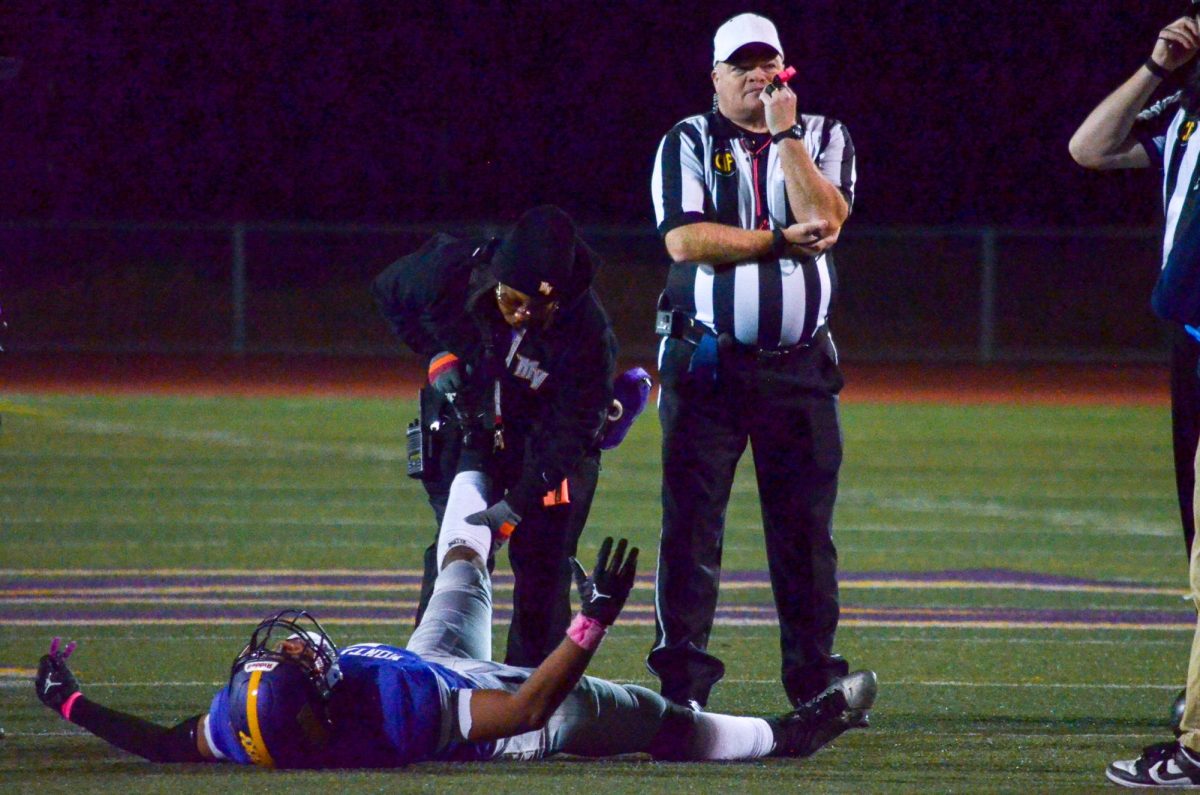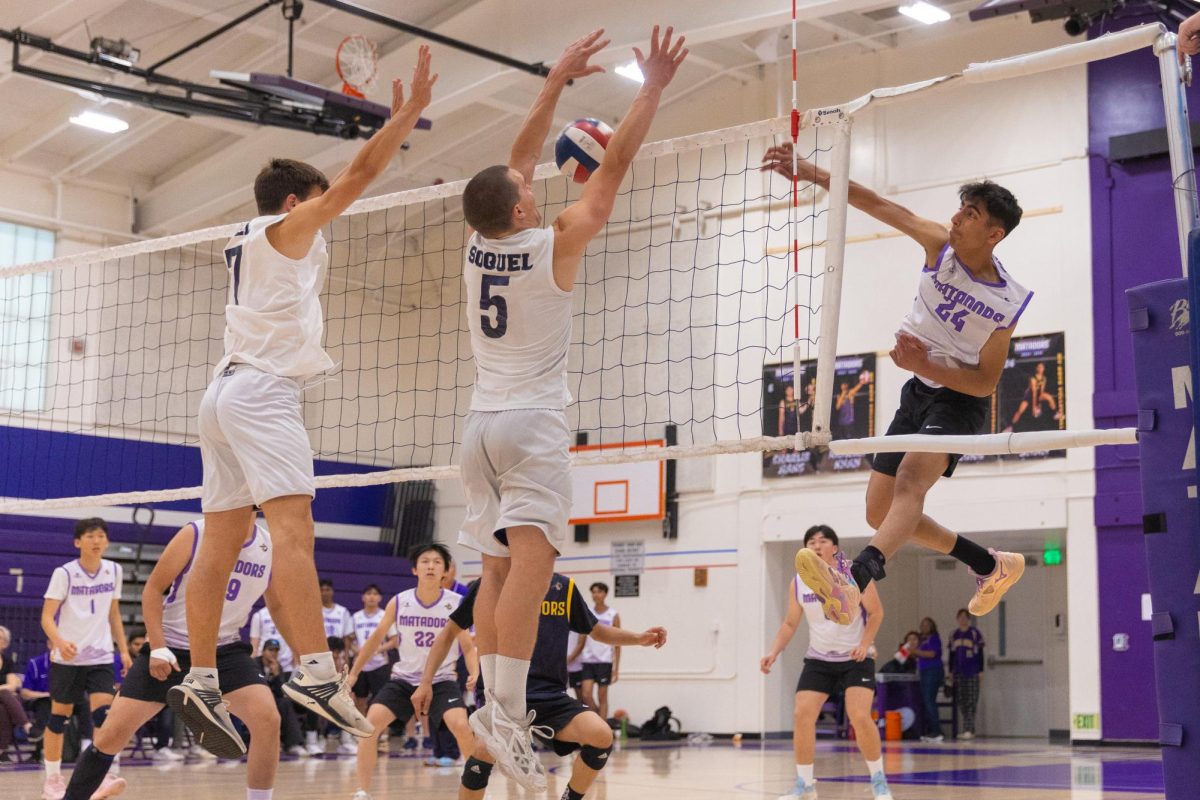Players and spectators at the Homecoming football game roared from the bleachers once MVHS tied the game, forcing overtime on Saratoga High School. Just seconds into the overtime period, an abrupt silence fell upon the crowd after a SHS player suffered a severe head injury. After junior and athletic trainer assistant Rahil Kanuga witnessed the injury happen, he initially believed it to be a routine injury until an automated external defibrillator was brought onto the field.
“I didn’t know what was going on, I thought it might have just been a regular injury,” Kanuga said. “It just makes you reconsider and think, ‘What if that happened to me while I was playing?’ But it can happen at all levels, so you just have to stay prepared for anything.”

Often labeled the most dangerous sport for youth due to the collision and contact aspect of the sport, football is one of the most injury-prone sports, and tackling produces more than half of the concussions suffered in high school football. Despite the risks and growing concerns surrounding the sport, Kanuga has been passionate about the game since he was young, when his interest was sparked by watching NFL games with his dad. A former running back and strong safety on the football team, Kanuga started playing football in third grade and ultimately joined the varsity team as a freshman because he was drawn to the speed and aggression of the game.
“When I started playing, I was a little concerned about injuries,” Kanuga said. “But once you start playing, you don’t really care because of how fun this sport is and you get attached to it after a certain point. It’s really fun because of the family and community that you have within football.”
Junior and strong safety Rocco Ling joined the team under the recommendation of his basketball coach due to his aggression and physical dominance in sports. Injuries were a big consideration when he initially joined, but he decided to still play as he wanted cool video edits made of his gameplay and found it amusing to hit and tackle other players.
However, at the beginning of his sophomore season, Ling suffered a fracture of the middle metatarsal in his right foot, causing him to miss most of the football season. Although the injury took an emotional toll on him, he still enjoyed watching football to some extent.
“I felt emotionally drained when the doctor diagnosed my injury because all the hard work I put in, from the end of last season to that season, was in vain since the injury occurred in week three,” Ling said. “During the injury, I still enjoyed football but not the way I wanted, because I had to sit out and be another face in the stands. But I bounced back pretty quick mentally once I was 100%.”
Similarly, Kanuga received a concussion and multiple severe shoulder dislocations due to an intense tackle. The repeated injuries to his shoulder required a labrum repair surgery, keeping him off the team this season. However, to maintain a strong bond with the team while he recovers, he enjoys assisting the Athletic Trainer and Health Clerk, Myesha Taylor, at practices and games.
“After the surgery, my parents were a little worried about me playing football again, but I think it’s something that got fixed and I can keep playing eventually,” Kanuga said. “I want to get back out there – I try to stay connected with the team, so now I help Myesha with ice and tape.”
According to Ling, the football coaches along with Myesha Taylor play a big role in how players minimize the likelihood of an injury, such as tackle practice and routine lifts. However, Taylor notes that despite the amount of safety measures taken, injuries are common and inevitable in football.
“Football is the only collision sport, so whenever you have people that are purposely hitting each other, you run the risk of injuries,” Taylor said. “There’s been a lot of steps taken to make it safer, but whenever you’re purposely running into each other, unfortunately, injuries occur.”
Taylor emphasizes focusing on strength and conditioning to help players’ muscles better protect their body, as well as stretching muscles before games. In addition to these precautionary measures, she also helps assess athletes’ injuries and gives recommendations on how to best recover. Ling strongly believes in the significance of recovery and wishes he fully understood its importance before he started football.

“Take recovery seriously because it can often be the difference between surviving or thriving in a season,” Ling said. “It also mitigates the chances and severity of injury which is beneficial for the long term, especially in a very physically demanding sport such as football.”
Despite Kanuga’s severe injuries that have left him unable to play football this season, he believes that the benefits of community and enjoyment far outweigh any potential health risks. He describes the football team as a true family, making the sport more fun as he plays with people that he feels close to.
“I don’t think you should be scared of getting hurt, because it’s something that’s bound to happen,” Kanuga said. “Every sport has a risk of getting hurt. There can be ways to make football a safer sport, but people are playing this sport for fun, and it’s something people really love to do.”
However, Taylor strongly believes that football is not worth getting severely injured, even with any benefits it might offer. Football has consistently had the highest injury rate out of all high school sports, ranging from 11.26 to 13.52 injuries per 1,000 times athletes participate in games or practices. In contrast, girls soccer, the second highest injury rate, has only around 5 injuries per 1,000 times athletes take part in its activities. Research even suggests that high school football players are even more at risk of having a concussion than college-level football players.
“For most players, football is just during high school and nothing else after,” Taylor said. “You’re doing permanent damage to your body – permanent for the rest of your life. Even going to a D1 doesn’t guarantee you will go to the NFL, so the price is too high. You’re not even getting paid for it.”
However, for Ling, the thrill of the game and the community with teammates often outweigh the potential consequences, arguing that every other collision sport also has a high risk of injury and it is impossible to fully avoid injuries anywhere. He believes that investing time into a sport is worth the rewards that can come out of his hard work, even after witnessing and suffering more severe injuries.
“I know the possibilities that come with this sport, so when we saw someone go down during the Homecoming game, I was not phased,” Ling said. “It only pushed me to take better care of myself. It showed me nothing’s ever promised and I must be grateful for every opportunity given to me because I never know when it will be my last.”













